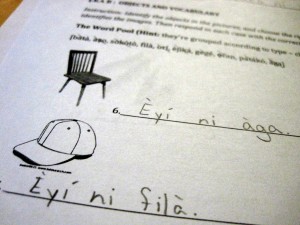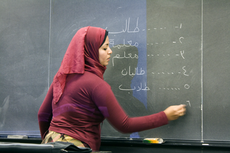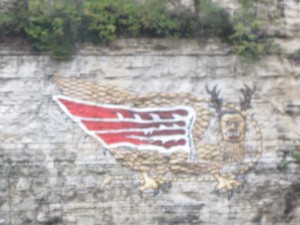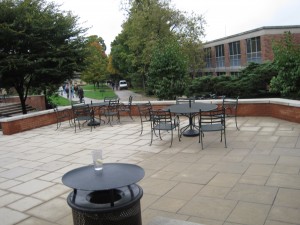 The test of students’ progress is not always as tricky if one is lucky to have listened to the students beforehand and to have understood what they are used to and what they are not. In most cases, as long as the teacher knows that his purpose in the test is not just to surprise and attack but to monitor his own progress, there would be less tears and heartbreaks when the day is over.
The test of students’ progress is not always as tricky if one is lucky to have listened to the students beforehand and to have understood what they are used to and what they are not. In most cases, as long as the teacher knows that his purpose in the test is not just to surprise and attack but to monitor his own progress, there would be less tears and heartbreaks when the day is over.
A few days before our mid-term test, I had given the students a list of areas to focus on, as well as how exactly to answer specific type of questions. There should be no one-word answers to questions requiring full sentence responses. There would be extra credit points for those who put the correct tone marks where necessary. There would be questions on personal introduction, identifying objects, numbers and greetings. And lastly, they should go over virtually everything we had learnt in class. After all, it was supposed to be a test of ability as well as hard work.
Beside the thirty questions that covered all we had learnt in class, there were also five extra-credit questions meant to help whomever needed it to get their grades up, and the questions there included “Kíni orúkọ olùkọ rẹ?”, “What is your adopted Yoruba name, and its meaning”, “Who is the author of the class novel ‘A Mouth Sweeter Than Salt’”, “Where was Suzanne Wenger originally from?” and “What’s the word for ‘zero’ in Yoruba?.
I have now finished marking (or scoring/grading in American English) the tests, and beside an overwhelming joy at how good they performed, I have made a few prominent observations:
- That none of them remembered my surname. It must have either been too long to remember.
- That many of them spelt “Good Afternoon” as “kassan” instead of “kaasan”. I’ve now told them that Yoruba does not have consonant clusters. That’s why when the word “brother” enters the language, it is pronounced as bùrọdá.
- That only a few of them knew the name of the author of the class novel. A few more remembered only the first name and not the surname, while a few knew the surname but couldn’t spell it.
- That everyone remembered the Yoruba word for “zero”.

- That some of the students studied beyond what they were taught in class. A case in point: even though I didn’t ask for plurals, a student responded to a question on identifying pens as “èyí ni awọn gègé.” (trans: here are some pens). I found that very impressive, and she was rewarded extra for it.
- That almost a quarter of the class didn’t remember their adopted Yoruba names, and half of those who did had forgotten the meaning. It was sure that they were not expecting to be asked about this in the exam.
- That some students would just NOT read the instructions on the exam question paper no matter how many times they’re told to do so, and notwithstanding the same instruction having been previously stressed again in the exam review materials.
- That there is always one student in class who would not perform well no matter how much help the teacher gives. S/he is either just lazy, or dull. The problem is, they are the ones who do not speak up when they don’t understand, for fear of being too prominent, when they should ordinarily be the most vocal.
I have my work cut out for me for the next half of the term.

 Seen on an office door at Principia College, Elsah Illinois.
Seen on an office door at Principia College, Elsah Illinois. Today, I went to the Principia College, Elsah Illinois with two professors from SIUe and another international student from here. Retired Professor Wilson had been invited to give a talk on diversity to a few students in the University, and it turned out to be a nice experience. The campus of the College (called University in Nigeria) is located at a site off the river road and overlooking the great Mississippi River. No words can describe the grandeur of the river as seen from the road while driving. I’m much convinced that it would look and feel so much better while on a bicycle. According to Prof Wilson, Mark Twain the writer used to come over to the river to get inspiration. Oh well.
Today, I went to the Principia College, Elsah Illinois with two professors from SIUe and another international student from here. Retired Professor Wilson had been invited to give a talk on diversity to a few students in the University, and it turned out to be a nice experience. The campus of the College (called University in Nigeria) is located at a site off the river road and overlooking the great Mississippi River. No words can describe the grandeur of the river as seen from the road while driving. I’m much convinced that it would look and feel so much better while on a bicycle. According to Prof Wilson, Mark Twain the writer used to come over to the river to get inspiration. Oh well. The journey to Principia took a little over thirty minutes from the SIUe campus, and we had to pass through a few small towns including Alton and Elsah, each with a repertoire of historical information, especially about the Native Americans that made the area their habitation for many years before their forceful dispersal. Alton has the famous Clark Bridge, and the even famous painting of a prehistoric piasa bird on the face of the cliff also overlooking the Mississippi river. According to Wikipedia, Alton has “its steep-sloped streets filled with silos, railroad tracks, and brick commercial buildings”, and it counts among its famous former residents Miles Davies, the legendary trumpeter/musician, Elijah Lovejoy, an abolitionist who was murdered in 1937 for his role in anti-slavery movements (and after whom the Library at SIUe is named), and James Earl Ray, the murderer of civil rights activist Martin Luther King Jnr.
The journey to Principia took a little over thirty minutes from the SIUe campus, and we had to pass through a few small towns including Alton and Elsah, each with a repertoire of historical information, especially about the Native Americans that made the area their habitation for many years before their forceful dispersal. Alton has the famous Clark Bridge, and the even famous painting of a prehistoric piasa bird on the face of the cliff also overlooking the Mississippi river. According to Wikipedia, Alton has “its steep-sloped streets filled with silos, railroad tracks, and brick commercial buildings”, and it counts among its famous former residents Miles Davies, the legendary trumpeter/musician, Elijah Lovejoy, an abolitionist who was murdered in 1937 for his role in anti-slavery movements (and after whom the Library at SIUe is named), and James Earl Ray, the murderer of civil rights activist Martin Luther King Jnr. One of the notable sights on the way from Edwardsville are the many oil refineries in Illinois that litter the way. “Those refineries refine the crude oil from Nigeria”, the professor quipped “before they are sold in the United States at different rates.” The crude oil is brought from different parts of the world – and indeed from Nigeria – in large ocean vessels, are refined, and sold as “gas”. What he didn’t know until I told him was that the finished petroleum products are also sold back to Nigeria – like chocolate products – at exorbitant prices whenever the steam engines of Nigeria’s refineries go down and the continent’s petroleum giant finds it hard to refine its own products. Passing through those areas of Illinois that I’ve never been before only reminded me of Nigeria’s Niger Delta: plenty smoke in the air, and plenty smell of gas – a depleting environment under serious gas pollution.
One of the notable sights on the way from Edwardsville are the many oil refineries in Illinois that litter the way. “Those refineries refine the crude oil from Nigeria”, the professor quipped “before they are sold in the United States at different rates.” The crude oil is brought from different parts of the world – and indeed from Nigeria – in large ocean vessels, are refined, and sold as “gas”. What he didn’t know until I told him was that the finished petroleum products are also sold back to Nigeria – like chocolate products – at exorbitant prices whenever the steam engines of Nigeria’s refineries go down and the continent’s petroleum giant finds it hard to refine its own products. Passing through those areas of Illinois that I’ve never been before only reminded me of Nigeria’s Niger Delta: plenty smoke in the air, and plenty smell of gas – a depleting environment under serious gas pollution. The Principia College is an institution for
The Principia College is an institution for